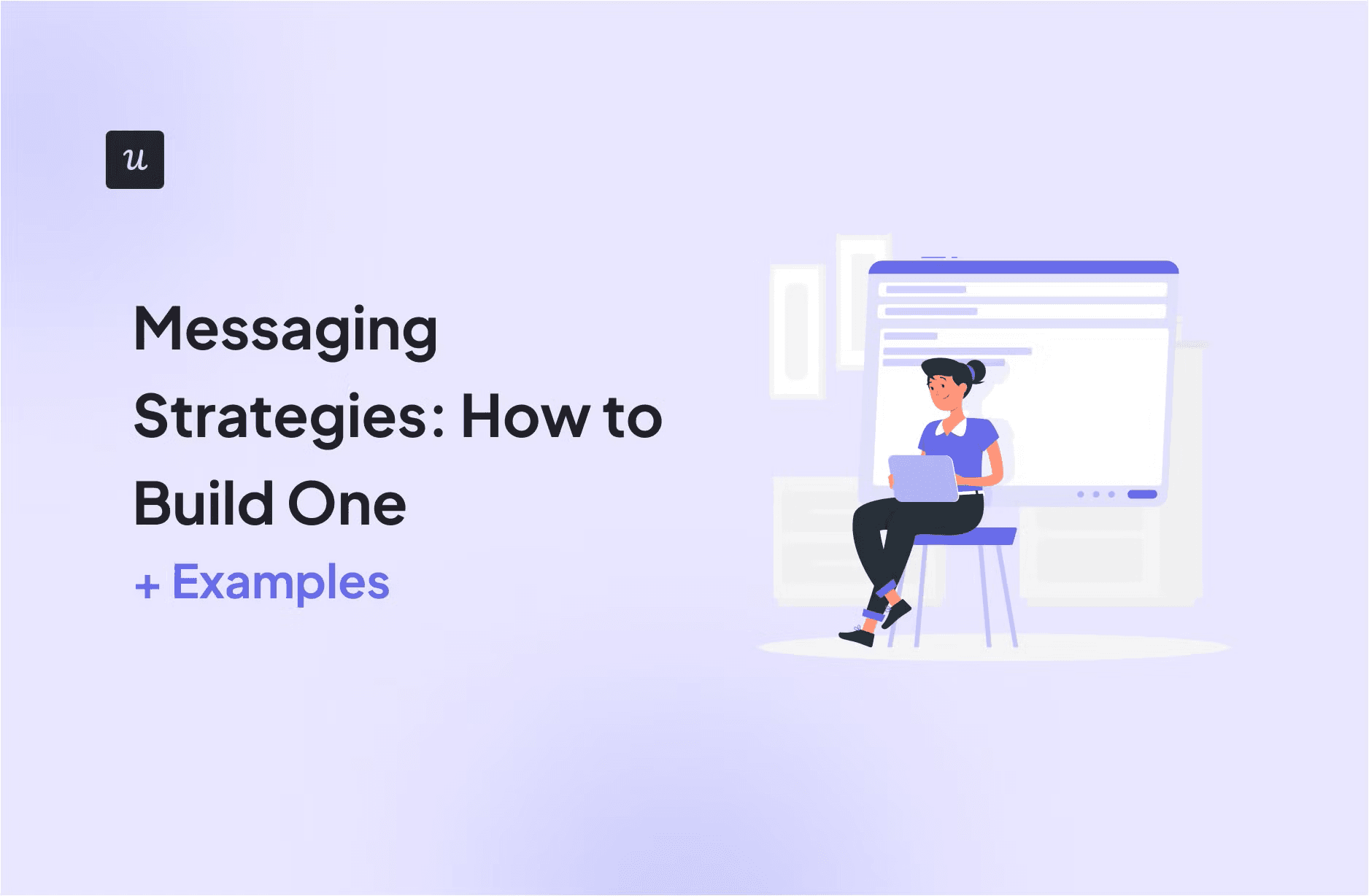
Try Userpilot Now
See Why 1,000+ Teams Choose Userpilot

What is a messaging strategy?
A messaging strategy is a marketing framework/plan that outlines how your brand communicates its key messages and unique selling proposition to its target audience. It includes what you say, how you say it, and how you ensure your communication succeeds.
What is the primary roadblock in your current messaging strategy?
Understanding the primary hurdle helps in refining your approach.
How do you identify your audience’s pain points for your messaging strategies?
Knowing your audience is the first step to effective communication.
How often do you A/B test your messages to optimize your messaging strategies?
Testing is key to discovering what truly resonates with your users.
Your messaging strategy is ready for an upgrade.
Userpilot can help you build effective, personalized messaging strategies by understanding user behavior, A/B testing in-app messages, and engaging users at the right time.
Why should you have a solid messaging strategy?
Before we get into the nitty-gritty, here’s why you need a messaging strategy in the first place:
- Clarity and consistency: A well-defined messaging plan ensures that product communication is clear and coherent across channels, so your audience understands (and trusts) your brand story and values.
- Differentiation: Strategic messaging highlights what makes your brand unique, showcasing features and benefits that set you apart from competitors. This helps you stand out and connect more deeply with your target market.
- Marketing effectiveness: A good messaging strategy enhances your marketing efforts by ensuring your campaigns resonate with your audience, leading to higher engagement and conversion rates.
- Enhanced brand awareness: Effective marketing messages ultimately lead to greater brand awareness since your audience quickly understands the product value you’re promising and why they need it.
How to build an effective messaging strategy
For a successful business, it’s crucial to develop your own messaging strategy that clearly articulates your values and connects with your target audience. Let’s look at how that’s done!
Identify your target audience and their pain points and needs
Developing messaging strategies starts with taking some time to understand your audience’s wants, needs, and pain points.
This enables you to tailor your marketing messaging and create targeted campaigns to address specific customer problems instead of churning out something generic. It makes your communication more relevant and impactful, fostering a stronger emotional connection with your brand.
Plus, knowing what customers want helps with better brand positioning, leading to increased engagement and conversion rates.
A good place to start is by creating user personas. Here’s how to do that:
- Gather demographic data, like age, gender, income, etc., through surveys, interviews, and other Voice of Customer research.
- Use analytics where possible to uncover insights into customer behaviors.
- Try social media listening to discover psychographic information like interests and hobbies.
- Lastly, combine all this into a detailed profile, highlighting challenges and how your product can address them, like the user persona example below.
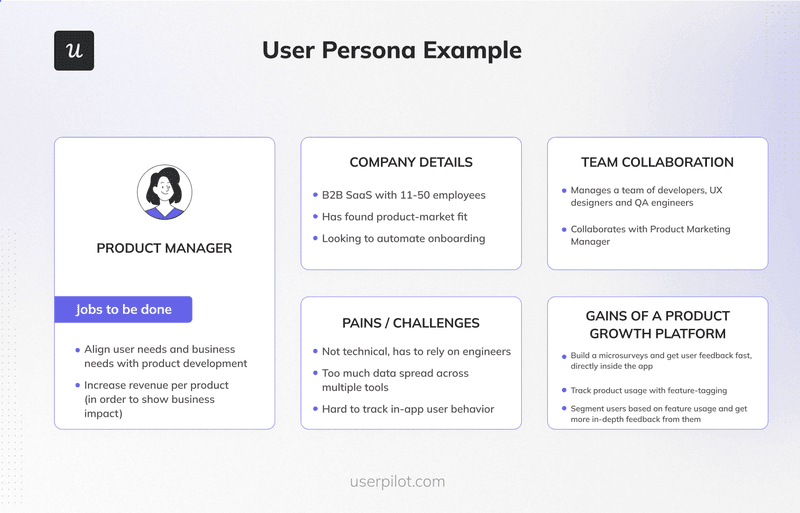
Have a clear messaging goal
A good messaging strategy is goal-driven and the best goals follow the SMART goal-setting format. This means they are Specific, Measurable, Attainable, Relevant, and Time-bound—everything you need to maximize success.
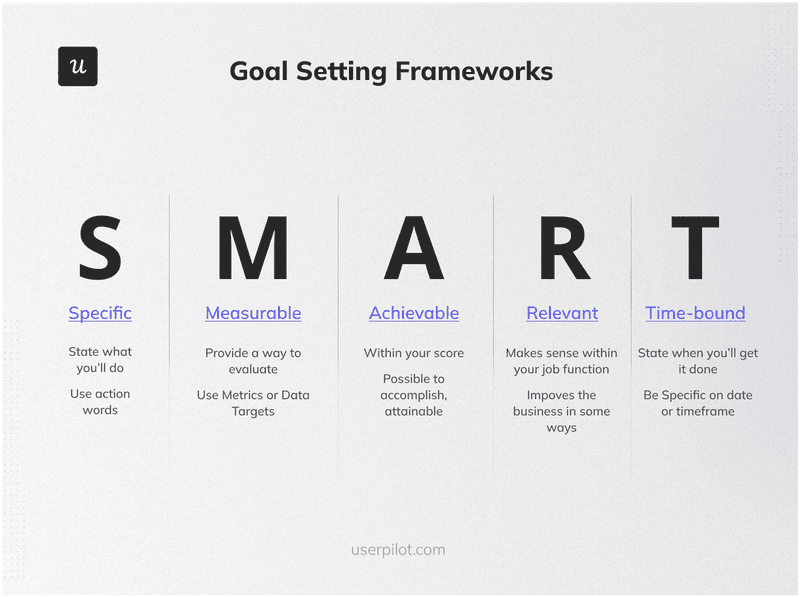
If you’re unsure what a SMART product goal might look like in practice, here’s an example that clearly defines the measurable goal in numbers, along with a realistic timeline:
“Increase brand awareness among small business owners in the software industry through a targeted email campaign. Aim for a 20% increase in open rates over the next three months.”
Define your unique selling proposition and communicate it with an effective core message
How do you make your brand memorable?
The answer: unique selling proposition (USP). USPs highlight features and qualities that set your product or service apart from competitors.
You can find your USP at the intersection of what you do best, what your customers desire, and what your competition lacks. Once defined, communicate these to your target audience by incorporating them into your marketing/advertising message strategy to build a strong product positioning.
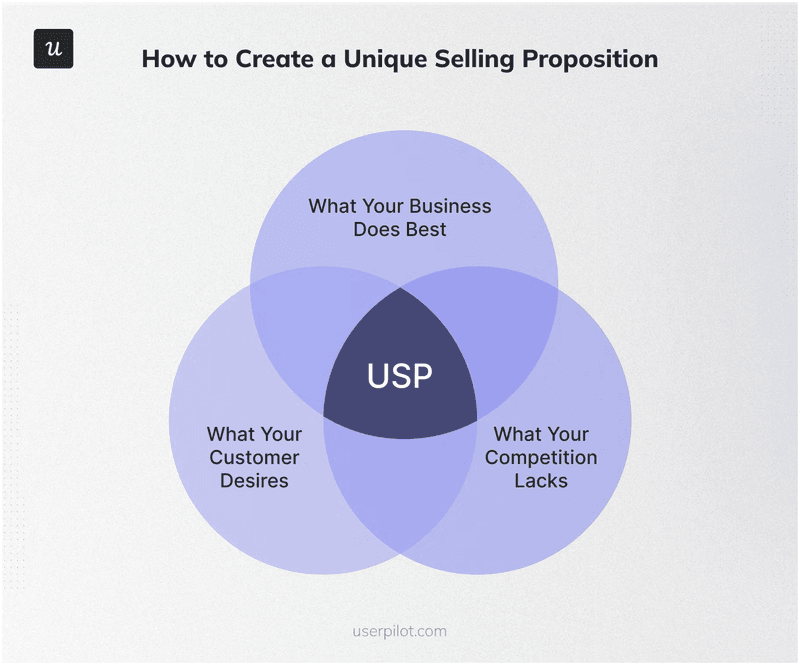
For example, Canva’s value proposition, “Empowering the world to design” emphasizes its simplicity and intuitiveness, while at the same time setting it apart from more complex design tools like Adobe Photoshop or Illustrator that target experienced users.
Personalize the messaging for users at different touchpoints across the customer journey
Customers move through multiple channels and platforms while interacting with your brand. An authentic message strategy is designed to meet the customer at each journey touchpoint.
To be effective, your message must reflect what customers are looking for at each step.
For example, a travel agency might send targeted ads featuring vacation packages to potential customers browsing travel blogs (Awareness stage). They could follow up with personalized emails offering exclusive deals to interested users (Consideration stage).
After a booking, they might share travel tips and destination guides (Post-Purchase stage), ensuring proactive support and relevant communication throughout the journey.
Analyze your competitors to develop a comparative messaging
Comparative marketing materials help you understand your competitive landscape and identify differentiation opportunities. By highlighting these differences through comparative messaging, consumers can see why your product is superior, which can sway their decision and lead to higher sales.
Here’s how to conduct such a competitive analysis:
- Research: Identify relevant competitors and analyze their messaging and strengths/weaknesses.
- Identify USPs: Highlight features that set your brand apart and matter most to customers.
- Create visuals: Use charts, graphs, or tables for clear comparisons.
- Focus on benefits: Emphasize how your offerings solve customer problems better.
Lastly, share drafts of comparative materials with your internal team for input and improvement. This will help refine your messaging strategies and equip your team with the insights needed to communicate effectively and engage customers.

A/B test different messages, analyze the results, and adjust
A/B testing isn’t meant for product managers alone. Before settling on marketing messaging strategies, test how they perform. Try different messaging, visuals, CTAs, segments, and channels, and note the best performers.
Manually implementing A/B tests and tracking results is nearly impossible. Consider product tools like Userpilot that enable you to easily design and set goals for your A/B tests and track test performances.
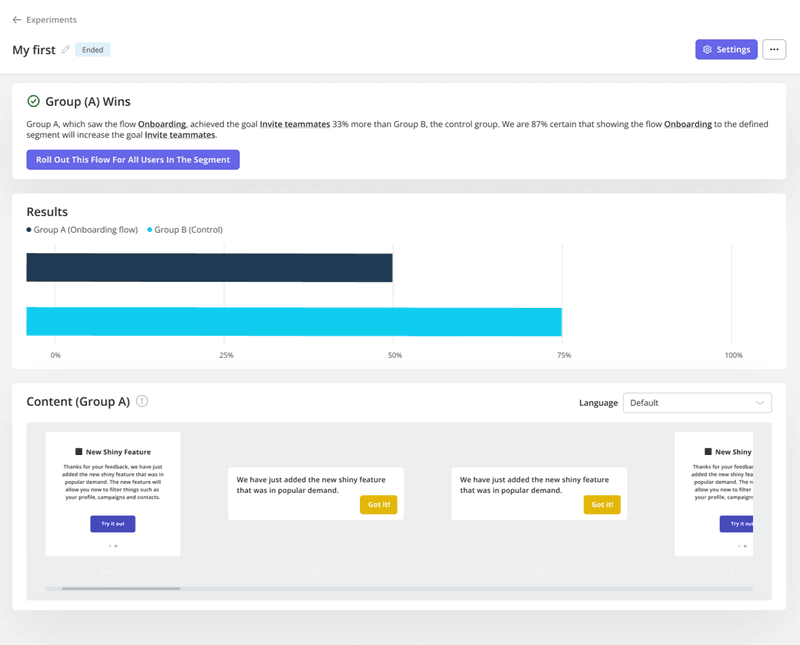
After analyzing the results, adjust your messaging strategies accordingly to increase audience engagement and marketing effectiveness.
Messaging strategy examples for different channels
The effectiveness of a marketing message also depends on the channel through which it is delivered. We will highlight message strategy examples for some key channels in this section.
In-product messaging strategies
In-product messages are messages displayed to your customers inside your product as they use it.
Note that this doesn’t include push notifications sent outside the app, but includes communication methods like tooltips, modals, product notes, and microsurveys.
In-app messages are received immediately and are highly relevant to the user’s current needs. They’re targeted and personalized based on the customer’s actions, making them a very powerful communication method.
An effective message strategy for in-app messages should focus on these key areas:
- Introducing new users to your product through in-app onboarding.
- Engaging users with tips and success messages.
- Increasing product revenue via upsells, referrals, and subscription expiry notifications.
Notice how Kommunicate uses a notification bar to inform customers about installing their chatbot integration:
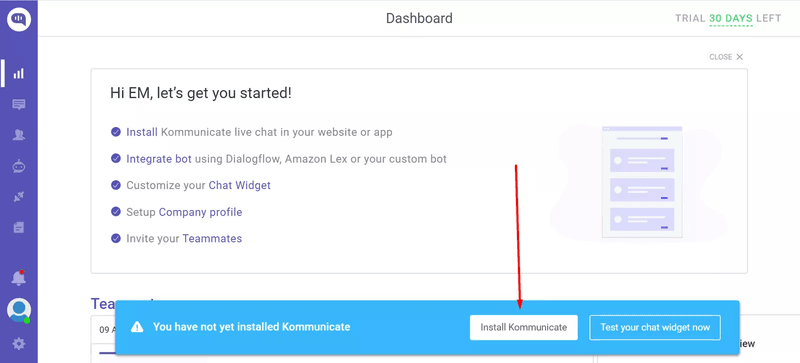
This notification bar helped increase the percentage of signup-to-chatbot integration from 40-45% to 55-60% in seven months. Explore the Kommunicate case study for more details.
Email messaging strategy
Email marketing remains a highly effective messaging strategy for driving growth and boosting new user activation—when used correctly.
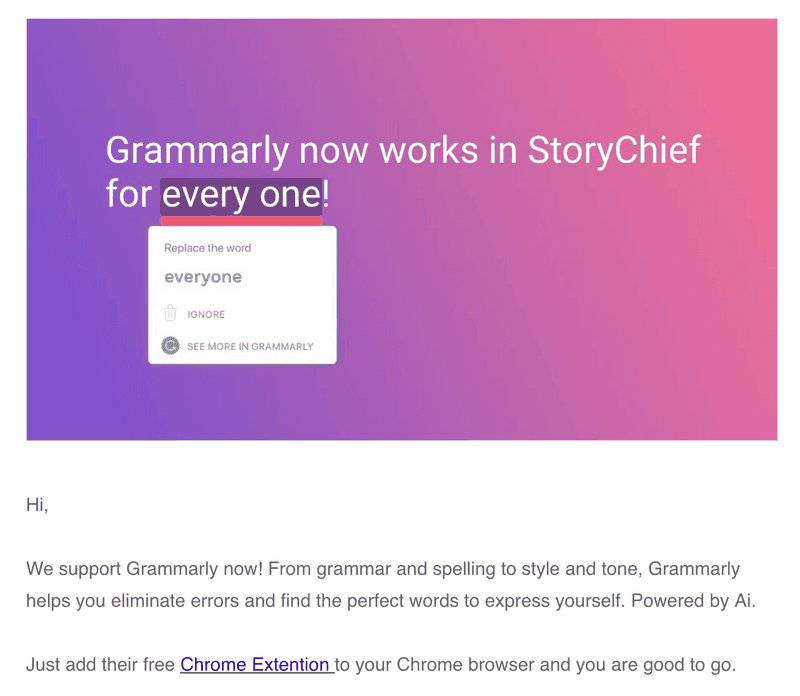
This messaging channel keeps you directly connected with your customers, ensuring you’re always within reach. However, you want to ensure that you’re not just adding to the noise in their mailbox.
Good email messaging strategies should:
- Be personalized to the user and their goals/needs.
- Be properly formatted for any device.
- Provide a clear opt-out option.
- Be specific to a purpose or goal.
- Include a clear call to action.
💡 The Userpilot and HubSpot integration can help personalize messaging by triggering emails based on in-app user behavior, ensuring your messages are relevant and contextual.
Social media messaging strategy
Unlike most messaging channels, social media provides instant feedback on how your message was received, making it an excellent gauge for your marketing messages. Plus, the potential virality social media offers also helps with greater word-of-mouth marketing.
Always test your social media messages to track performance across different audiences. Monitor your posts, images, infographics, and topics, and double down on those that deliver the best results.
To ensure your social media messaging is effective, you should:
- Be human. People appreciate talking to humans rather than “brands”, so communicate with sincerity.
- Use visuals to enhance your message.
- Tailor your message for each social media channel.
- Design the post to drive engagement.
- Craft your content to match current issues.
Consider this sample social media message from the project management tool ClickUp and how it offers a solution to a major project challenge its customers may face.
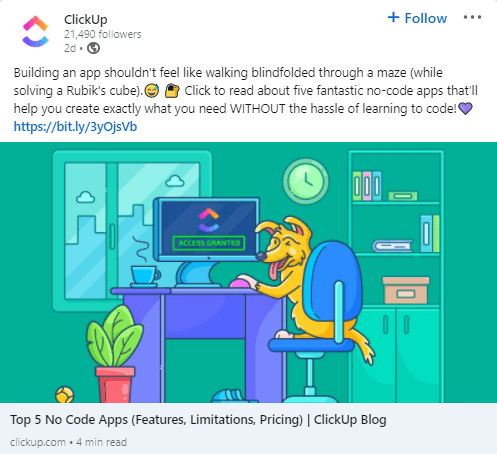
External channels brand messaging strategy
External channel communications encompass all of the media through which you capture the public’s attention. This includes everything from shareholder-centered presentations to press releases, newsletters, conferences, webinars, and even your positioning on Product Hunt.
To ensure your external channels message strategy is effective, you should:
- Know your audience and what resonates with them.
- Choose the best platform for your target audience, brand, and message.
- Offer real value with your message.
For instance, the Userpilot Product Drive 2024 event, hosted on HeySummit, connects Userpilot with its target audience—product managers and marketers.
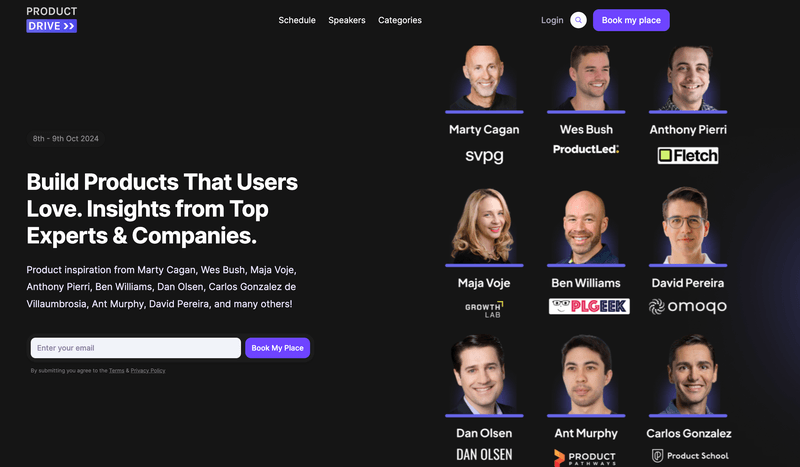
Website messaging strategy
Your website messaging strategy needs to go beyond simply mentioning your value proposition on each landing page. To be more effective, here are a few tips to incorporate into your strategy:
- Use simple language: Avoid industry jargon and keep your messaging straightforward to enhance understanding.
- Incorporate strong CTAs: Encourage users to take specific actions, such as signing up or requesting a demo.
- Leverage social proof: Include testimonials, case studies, or user reviews to build credibility and customer trust.
- A/B test your messaging: Regularly test different headlines, layouts, and CTAs to see what brand messages resonate best with your target market.
- Consistent messaging across channels: Any discrepancies between, for example, social media posts and your website can confuse customers and cause mistrust.
For example, our landing page incorporates the following best practices:
- Relevant, actionable CTA text.
- Impactful customer testimonial.
- Clearly highlighted benefit (faster, personalized onboarding and no coding).
- More social proof by mentioning 1,000+ customers.
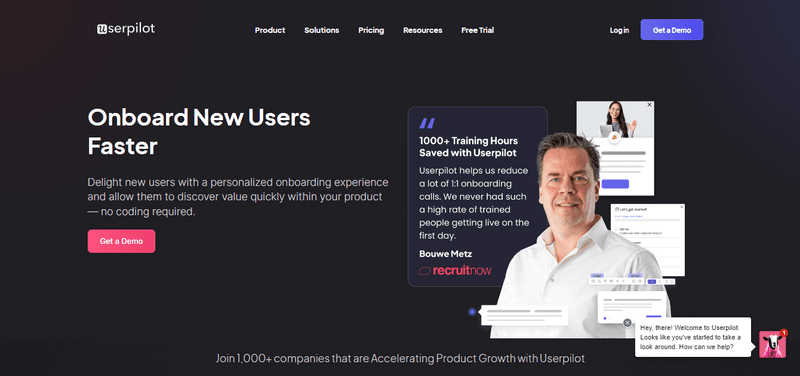
Paid ads messaging strategy
While paid ads sound like an attractive opportunity to win over customers, it isn’t that simple. You need a well-crafted advertising messaging strategy if you truly want to increase conversions. Here are some tips that should help:
- Use attention-grabbing headlines that clearly convey the value you offer.
- Highlight the key benefits of your product, service, or brand rather than just features.
- Add compelling calls to action that encourage immediate engagement.
- Tailor your ads based on the interests and behaviors of different customer segments.
- Leverage urgency and FOMO with time-sensitive offers to prompt quick action.
A key goal in advertising is to create messages that both inform and persuade the audience. For example, our ad is product-focused, concise, emphasizes benefits, and includes specific features relevant to the target audience.

Messaging strategy best practices
At this point, you should have formed some ideas on what your brand messaging strategy should look like. Before signing off on any strategy, though, ensure it adheres to the following product marketing best practices:
Keep consistency across different channels
Your message should always maintain consistency, regardless of your chosen channel or platform.
All brand messaging across your website, blog posts, newsletters, and social channels should feel like they were written by one person for one customer. A consistent message also helps avoid confusion or potential customer frustration.
To guarantee this coherence, create message strategy guidelines for internal use. This ensures everyone on your team adheres to the same tone and messaging principles, irrespective of the acquisition channels.
Make it personal
Whatever your chosen strategy, your message should feel personal to the reader. It should identify their pain points and address them in their language to build an emotional connection. The more your message resonates with the customer, the more impactful it’ll be.
Include storytelling to relate to your audience
Storytelling has always been a creative way of attracting customers and delivering crucial information in an entertaining way. It humanizes your brand, gives the audience a glimpse into your values, and makes your message more relatable and memorable.
In short, by weaving narratives into your messaging marketing, you can engage users on a much deeper level.
Userpilot’s video ad below serves as a good example of product storytelling, engaging viewers with a relatable scenario, fun narration, and a simple solution.
Conclusion
Messaging strategies are your chance to create meaningful connections with customers. Get it right, and you’ll see audience engagement and conversions increase. But get it wrong, and you potentially ruin your brand and everything it stands for.
To avoid the latter, keep the key best practices in mind, like consistency, personalized targeting, and experimenting with your messaging. And don’t forget—take time out to truly understand your target audience before you start marketing to them!
Want to understand user behavior and craft tailored in-app messages for higher activation and engagement? Get a Userpilot demo to learn how we can help you!







